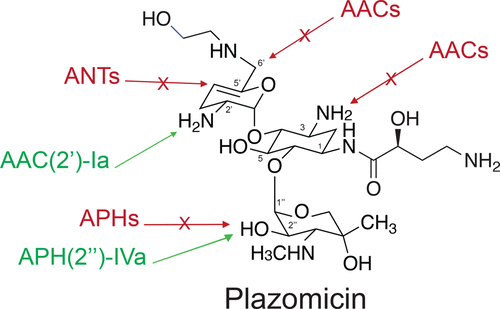当前位置:
X-MOL 学术
›
ACS Infect. Dis.
›
论文详情
Our official English website, www.x-mol.net, welcomes your feedback! (Note: you will need to create a separate account there.)
Plazomicin Retains Antibiotic Activity against Most Aminoglycoside Modifying Enzymes
ACS Infectious Diseases ( IF 5.3 ) Pub Date : 2018-04-10 00:00:00 , DOI: 10.1021/acsinfecdis.8b00001 Georgina Cox 1 , Linda Ejim 1 , Peter J. Stogios 2 , Kalinka Koteva 1 , Emily Bordeleau 1 , Elena Evdokimova 2 , Arthur O. Sieron 1 , Alexei Savchenko 2, 3 , Alisa W. Serio 4 , Kevin M. Krause 4 , Gerard D. Wright 1
ACS Infectious Diseases ( IF 5.3 ) Pub Date : 2018-04-10 00:00:00 , DOI: 10.1021/acsinfecdis.8b00001 Georgina Cox 1 , Linda Ejim 1 , Peter J. Stogios 2 , Kalinka Koteva 1 , Emily Bordeleau 1 , Elena Evdokimova 2 , Arthur O. Sieron 1 , Alexei Savchenko 2, 3 , Alisa W. Serio 4 , Kevin M. Krause 4 , Gerard D. Wright 1
Affiliation

|
Plazomicin is a next-generation, semisynthetic aminoglycoside antibiotic currently under development for the treatment of infections due to multidrug-resistant Enterobacteriaceae. The compound was designed by chemical modification of the natural product sisomicin to provide protection from common aminoglycoside modifying enzymes that chemically alter these drugs via N-acetylation, O-adenylylation, or O-phosphorylation. In this study, plazomicin was profiled against a panel of isogenic strains of Escherichia coli individually expressing twenty-one aminoglycoside resistance enzymes. Plazomicin retained antibacterial activity against 15 of the 17 modifying enzyme-expressing strains tested. Expression of only two of the modifying enzymes, aac(2′)-Ia and aph(2″)-IVa, decreased plazomicin potency. On the other hand, expression of 16S rRNA ribosomal methyltransferases results in a complete lack of plazomicin potency. In vitro enzymatic assessment confirmed that AAC(2′)-Ia and APH(2′′)-IVa (aminoglycoside acetyltransferase, AAC; aminoglycoside phosphotransferase, APH) were able to utilize plazomicin as a substrate. AAC(2′)-Ia and APH(2′′)-IVa are limited in their distribution to Providencia stuartii and Enterococci, respectively. These data demonstrate that plazomicin is not modified by a broad spectrum of common aminoglycoside modifying enzymes including those commonly found in Enterobacteriaceae. However, plazomicin is inactive in the presence of 16S rRNA ribosomal methyltransferases, which should be monitored in future surveillance programs.
中文翻译:

Plazomicin保留针对大多数氨基糖苷修饰酶的抗生素活性。
Plazomicin是目前正在开发的新一代半合成氨基糖苷抗生素,用于治疗因多重耐药性肠杆菌科细菌引起的感染。该化合物是通过对天然产物sisomicin进行化学修饰而设计的,以提供保护,使其免受常见的氨基糖苷修饰酶的伤害,这些酶通过N-乙酰化,O-腺苷酸化或O-磷酸化来化学改变这些药物。在这项研究中,吡唑米星是针对一组大肠杆菌的同基因菌株进行分析的分别表达二十一种氨基糖苷抗性酶。Plazomicin对测试的17种修饰酶表达菌株中的15种保留了抗菌活性。仅两个修饰酶,aac(2')-Ia和aph (2'' )-IVa的表达降低了吡唑米星的效力。另一方面,16S rRNA核糖体甲基转移酶的表达导致完全缺乏普拉佐米星效价。体外酶促评估证实,AAC(2')-Ia和APH(2'')-IVa(氨基糖苷乙酰基转移酶,AAC;氨基糖苷磷酸基转移酶,APH)能够利用吡唑米星作为底物。AAC(2')-Ia和APH(2'')-IVa的分布仅限于斯图尔特氏普罗旺斯和肠球菌。这些数据表明,吡唑米星不能被广泛的常见氨基糖苷修饰酶(包括肠杆菌科中常见的修饰酶)修饰。但是,在存在16S rRNA核糖体甲基转移酶的情况下,吡唑米星是无活性的,应在以后的监测程序中对其进行监测。
更新日期:2018-04-10
中文翻译:

Plazomicin保留针对大多数氨基糖苷修饰酶的抗生素活性。
Plazomicin是目前正在开发的新一代半合成氨基糖苷抗生素,用于治疗因多重耐药性肠杆菌科细菌引起的感染。该化合物是通过对天然产物sisomicin进行化学修饰而设计的,以提供保护,使其免受常见的氨基糖苷修饰酶的伤害,这些酶通过N-乙酰化,O-腺苷酸化或O-磷酸化来化学改变这些药物。在这项研究中,吡唑米星是针对一组大肠杆菌的同基因菌株进行分析的分别表达二十一种氨基糖苷抗性酶。Plazomicin对测试的17种修饰酶表达菌株中的15种保留了抗菌活性。仅两个修饰酶,aac(2')-Ia和aph (2'' )-IVa的表达降低了吡唑米星的效力。另一方面,16S rRNA核糖体甲基转移酶的表达导致完全缺乏普拉佐米星效价。体外酶促评估证实,AAC(2')-Ia和APH(2'')-IVa(氨基糖苷乙酰基转移酶,AAC;氨基糖苷磷酸基转移酶,APH)能够利用吡唑米星作为底物。AAC(2')-Ia和APH(2'')-IVa的分布仅限于斯图尔特氏普罗旺斯和肠球菌。这些数据表明,吡唑米星不能被广泛的常见氨基糖苷修饰酶(包括肠杆菌科中常见的修饰酶)修饰。但是,在存在16S rRNA核糖体甲基转移酶的情况下,吡唑米星是无活性的,应在以后的监测程序中对其进行监测。



























 京公网安备 11010802027423号
京公网安备 11010802027423号